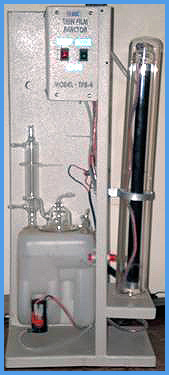
- SAIC
THIN - FILM REACTOR

This Thin film reactor is designed
and best suited for irradiations of small volumes of reactant ranging
from 50ml to 500ml and/or concentrated solutions where radiation only
penetrates a fraction of a mm. The reactant solution is pumped from
reservoir through a glass jet and thin film of liquid falls under
gravity over quartz or borosilicate closed tube. A low pressure mercury
lamp or phosphor-coated lamp mounted inside this tube ensures even
irradiation of this falling film. By reversing the flow direction
the reactor may be used for irradiation of 5 mm path-length of solution
in a conventional flow reactor arrangement.
Lamps and Power Supplies
Five standard emission lamps are
available for use in this reactor, all being of identical size and
electrical characteristics. The spectral characteristics are shown
in the figures or the 350nm, 410 nm and white lamps. The 254nm lamp
has no phosphor coating and emits over 90% of its radiation at 254
nm.
Lamp characteristics
| Lamp type | Peak emission | Comments | Model |
|---|---|---|---|
| 254 | 254 nm | Requires quartz tube (QW3) | TFQ3 |
| 350 | 350 nm | Use with borosilicate (BW3) or quartz (QW3) tube | TFB4 |
| 410 | 410 nm | Use with borosilicate (BW3) or quartz (QW3) tube | TFB5 |
| White | See spectrum | Covers entire visible spectrum | TFB6 |
| PAR | 436, 650 nm | Strong emission at absorption, Bands of chlorophyll | TFB7 |
The 350 nm lamp (model TFB4) produces
4X1018 photons/s in the thin-film reactor as measured by benzophenone/isopropanol
actinometry and representative spectral trace of changes with irradiation
time is shown.
All these lamps my be used in a large immersion wells (models TFB7 and TFB5). The 254 nm lamp, for example, produces 2X1018 photons/s in the large quartz well as measured by ferrioxalate actinometry. The lamps are also used in the multilamp reactor (see page 6). Lamps have a nominal power consumption of 15 W, are 445 mm overall length and 25 mm diameter.
All these lamps my be used in a large immersion wells (models TFB7 and TFB5). The 254 nm lamp, for example, produces 2X1018 photons/s in the large quartz well as measured by ferrioxalate actinometry. The lamps are also used in the multilamp reactor (see page 6). Lamps have a nominal power consumption of 15 W, are 445 mm overall length and 25 mm diameter.
Lamp power supply
All lamps type TFQ3 - TFB7 operates
from the same power supply which is built into the control unit for
the thin-film photoreactor. The control unit operates the pump and
lamp.
Irradiation tubes
Double walled irradiation tubes (of
quartz or borosilicate glass) are used in this reactor. Tubes are
equipped with threaded glass entrance and exit ports to which are
attached the liquid jet tube and exit tubing. In the reverse flow
arrangement, the jet tube is removed.
Depending on the size of the jet and setting of the bypass control, flow rates through the jet may be varied from 0.1 to 1 ml/s. Film thickness depend on flow rate and the solvent used but are of the order of 0.1 to 0.3 mm.
| Material | Inside Dia (mm) | Outside Dia (mm) | Overall Length (mm) | Wall Separation (mm) | Model |
|---|---|---|---|---|---|
| Quartz | 46 | 59 | 500 | 5 | QW4 |
| Borosilicate | 46 | 59 | 500 | 5 | BW4 |
Depending on the size of the jet and setting of the bypass control, flow rates through the jet may be varied from 0.1 to 1 ml/s. Film thickness depend on flow rate and the solvent used but are of the order of 0.1 to 0.3 mm.
Pump and tubing
A self-priming liquid pump, which
is capable of handling mixtures of liquid and air, is used in this
reactor. Being a diaphragm pump, the pumping solution is not contaminated
by lubricants in the pump and is only in contact with stainless steel
or PTFE tubing.
Sample reservoir
The standard flask supplied with
this reactor is a 250ml capacity round- bottomed flask (see figure).
The flask is equipped with one central port (29/32) and two side ports
(14/23) Sockets provided with entrance tubes (and sinters) are used
for connection to the pump and irradiation tube and an external gas
cylinder (for studies under a reactive or inert atmosphere). Loss
of solvent is prevented by use of a double surface condenser (model
RC1), which fits into one of the side ports. The minimum usable volume
is about 50 ml of solution. Flasks of larger capacity are also available.
Flow-through cells
The thin-film reactor is ideally
suited for continuous monitoring of a photochemical reaction by changes
produced (in reactant depletion or product formation) which may be
monitored by UV/visible absorption spectroscopy or florescence spectroscopy.The
reactor is simply positioned close to a spectrometer and the flow
cell connected to the reactor with PTFE tubing. Two cuvettes are available,
one a 10 mm pathlength far-UV quartz rectangular cell with three sides
polished (for absorption or fluorescence) model 116 and the other
a 2 mm pathlength far-UV quartz rectangular cell with two sides polished
(for absorption), model 117.
Reactor housing
The component parts of the reactor
are housed in a robust metal housing (see figure) provided with a
heavy metal base. A central metal support plate holds the irradiation
tube on one side and the reservoir and pump assembly on the other.
Connections are provided for (a) water-cooling for the reflux condenser,(b)
gas-inlet and (c) flow-through connections for spectrometric monitoring
(fluorescence on UV/visible absorption). Detachable covers are provided
on both sides of the support plate. Electrical connections are provided
between the reactor assembly and control unit. Power supply requirements
220 -250VAC, 100W.
